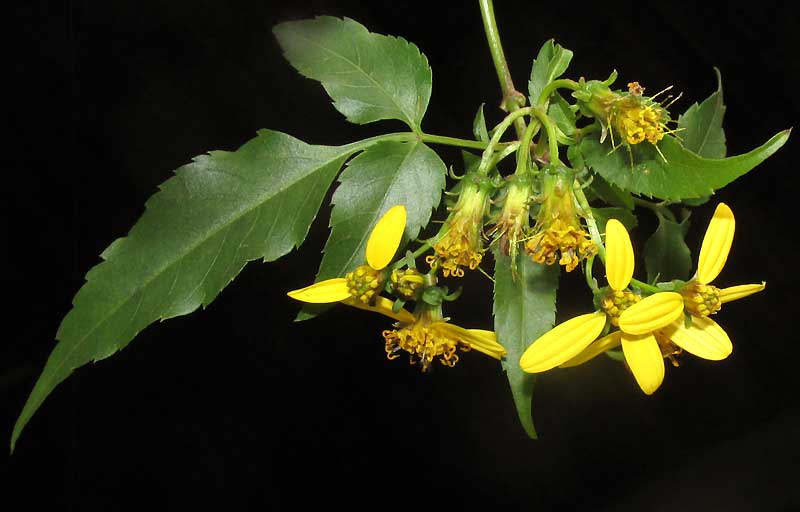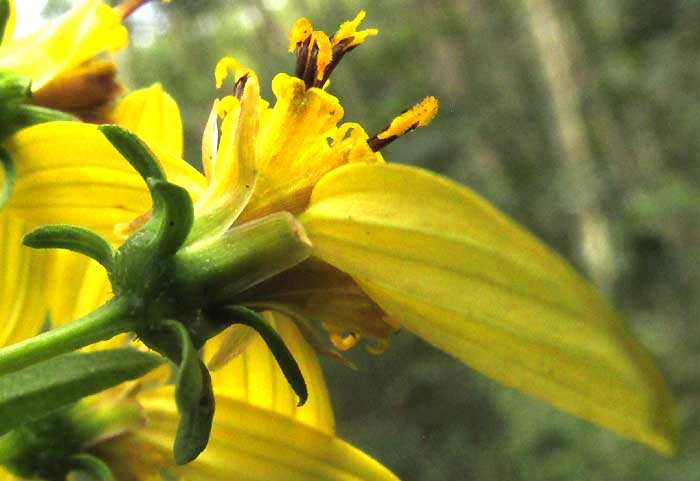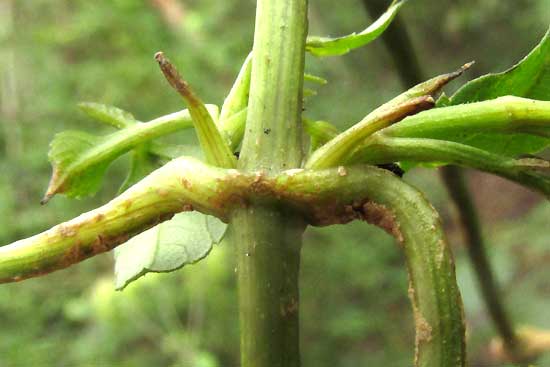Excerpts from Jim Conrad's
Naturalist Newsletter
from the February 1, 2019 Newsletter issued from Rancho Regensis north of Valladolid, Yucatán, MÉXICO;
elevation ~40m (~130 ft), N~20.876°, W~88.170°
"CLIMBING STICK-TIGHTS"
During this season when most trees slowly are losing their leaves because of the advancing dry season, right beside the hut in which I live a vine has begun flowering. Below, you can see dispersed clusters of the yellow blossoms exactly as I see them as I type this:

Up close it's clear that this is a member of the huge Composite/Aster/Sunflower Family, the Asteraceae, because flower-like heads consist of several tiny individual flowers, as shown below:

North American wildflower fanciers will recognize both the pinnate leaves and the flowers as similar to what's variously called stick-tights, Spanish needles, or tickseeds. In the fall, stick-tights sometimes turn roadsides and entire weedy fields yellow with their blossoms,, and when you walk through them your clothes end up carrying dark, little tick-like items hanging on with tiny, barbed, needle-like spines. Several species go by that name, but typically when we use those names we're referring to members of the genus Bidens. Moreover, in the above picture you can see certain "needles" projecting from flower clusters. It really looks like a Bidens, but Bidens species are supposed to be wildflowers or weeds, not vines climbing in trees...
Up closer, the flowering heads look even more like they belong on knee-high stick-tight plants, as shown below:

The collection of green bracts, or the "involucre," subtending each flower head of species in the genus Bidens do something special. The bottom-most ones are thick and green while the upper or inner ones are thinner and often paler. Our hut-side vine's involucral bracts match that description, as seen below:

That observation sends us looking for more indications that this is actually a climbing, viny stick-tight, a Bidens, because, at least to a northerner, that would be surprising. In the genus Bidens the petal-like ray flowers issuing from the sides of the flower heads can be yellow or white, and ours are yellow. The tiny, closely-packed, cylindrical disc flowers in the heads' centers are yellow, and our vine's disc flowers are yellow, too, shown below:

In that picture the dark brown items are pollen-producing anthers fused along their sides, forming a cylinder around each the style, atop which two yellow stigmas emerge and become Y-shaped. Stigmas are where pollen grains from other flowers land, germinate, and send their male sex germs down through the style to the ovary at the flower's bottom, and that ovary then will mature into a one-seeded fruit. If you break away one side of the flower head you can see what's shown below:

At the right in that picture a disc flower has pulled away clearly showing the yellow corolla atop the ovary, which already is taking the form of a typical stick-tight of the genus Bidens. See the two upward-projecting, barbed "needles" that later will so stubbornly stick to your trousers or hairy legs? A last picture showing details of one of the vining stem's nodes -- where leaves and sprouts arise -- appears below:

So, our vine is indeed a climbing stick-tight. It's BIDENS REPTANS*, generally distributed throughout the American tropics. It has no commonly used English name, so our name "climbing stick-tight" is a made-up one, just for us. But English speakers need such a name so they can talk about this climbing Bidens, and ask one another what a vine needs such needle-bearing stick-tights for up in the air where no trouser legs or hairy legs go wandering through. Squirrels, bats, monkeys, kinkajous... ?
As I type this many bees buzz around our climbing stick-tight's flowers, so I know that what Juan told me is true, that this is an important plant for them.
Also, online I see that in 2008 MC Pérez-Amador and others published an article in the journal Phyton (B. Aires) on the biological activity of phototoxic compounds in Bidens squarrosa [reptans]. Our plant was chosen because it had not been studied, despite the fact that leaf infusions made from other species of the genus Bidens have been used traditionally to treat influenza, swollen and sore throat, and dysentery. They found that extracts of Bidens squarrosa [reptans] showed significant antibacterial and antiinflammatory activity, deciding that "Results obtained in this study validate the use of Bidens squarrosa as a medicinal plant."